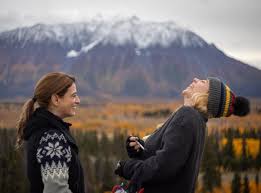A little culture shock can be disconcerting … but how about a 114-degree temperature change?
That’s what Liliana Penuelas experienced. A Cuban native living in Puerto Rico, she decided to join a friend in Alaska’s northern-most city.
When she left, she tells Pati Jinich in a PBS film Tuesday (April 29), it was 90 degrees. When she arrived, it was minus-24. “I thought, ‘What are you doing?!?’”
But she stayed. Now, 34 years later, she’s married to a Mexican native. They have what Jinich (shown here, left) assures us is the only sit-down Mexican restaurant in Utqiagvik, Alaska.
Many such surprises emerge in “Pati Jinich Explores Panamericana,” at 10 p.m. Tuesdays.
In the series, Jinich follows the 19,000 mile Pan-American Highway, from the northern tip of the U.S. to the southern one of Argentina. But the opener sticks to Alaska, starting with Utqiagvik, which is 330 miles north of the Arctic Circle.
The town has drawn occasional attention, usually under its old name (changed in 2016) of Barrow. Will Rogers died in a plane crash near there. ESPN was there for a series about its high school football team; it was one of the stops in the TV series and book “Stephen Fry in America.”
Fry, an Englishman, was not pleased with the weather. “I am wrapped in the thickest, most professional cold-weather clothing I could find, and it is still not warm enough,” he wrote in the book (HarperCollins, 2008). “I am beginning to revise my oft-repeated assertion that I would rather be too cold than too hot.”
Actually, Utqiagvik (pronounced “utqiagvik”) has temperatures modified by topography. It has never dropped below minus-56. (Alaska has reached minus-80, Jinich says.) Three of its months have never even been below zero.
Jinich wisely arrived during one of those months. Since sled dogs need to exercise year-round, Geoff Carroll hitched them up to his all-terrain vehicle.
Carroll, originally from Wyoming, is retired after 27 years as the regional biologist. He’s survived two bush-plane crashes, a 1,000-mile dog-sled trip to the North Pole … and a polar bear attack.
“The gun jammed,” he tells Jinich, “so I took it around and used it for a baseball bat.”
That stunned the bear and broke the rifle. Carroll drew a reputation as the man who won a fight with a polar bear.
That story is what caused his wife Marie to meet him. She’s Inupiat, as are the majority of people in the town, and led the Alaska Eskimo Whaling Commission, lobbying successfully in Washington, D.C.
Such combinations fascinate Jinich, 43, who is Mexican and Jewish, with Polish roots. She finds rich ethnic blends throughout the state; one Alaska music quintet has people who are Japanese, Korean, Puerto Rican, Inuit and from the mainland U.S. In a 350-person village near Anchorage, Russian emigres preserve their original language, religion and traditions.
In Utqiagvik, planes land daily at an airport named for Rogers and his friend and pilot, Wiley Post. “If a cargo plane misses a flight, grocery stores start to be empty,” Jinich says in the film.
The setting is unusual. Fry wrote that this “is a coastal town, which is hard to verify when the sea is frozen.” He did manage a journey on a whaling ship “not much bigger than an average suburban dining table” and was relieved that no whales were sighted.
Here, life goes on. There’s a high school football team (playing on artificial turf), a high school basketball team (one player went on to college ball in Texas and Hawaii) and a two-year college that provides the town library.
There are lots of drive-through coffee places, which seem common throughout Alaska. And there are 4,927 people, including a Cuban-Puerto Rican baker and a Wyoming biologist who won a fight with a polar bear.

Want some culture shock? Try Utqiavik, Alaska
A little culture shock can be disconcerting … but how about a 114-degree temperature change?
That’s what Liliana Penuelas experienced. A Cuban native living in Puerto Rico, she decided to join a friend in Alaska’s northern-most city.
When she left, she tells Pati Jinich in a PBS film Tuesday (April 29), it was 90 degrees. When she arrived, it was minus-24. “I thought, ‘What are you doing?!?’”
But she stayed. Now, 34 years later, she’s married to a Mexican native. They have what Jinich (shown here, left) assures us is the only sit-down Mexican restaurant in Utqiagvik, Alaska.
Many such surprises emerge in “Pati Jinich Explores Panamericana,” at 10 p.m. Tuesdays. Read more…